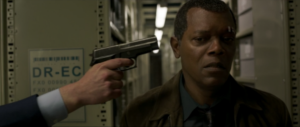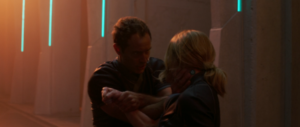63
“Captain Marvel: Between Three Empires”
By Phoenix Angulo
Hand-beams, cat-alien, and a masterfully de-aged Samuel L. Jackson. Captain Marvel is a fan-pleasing blockbuster built on a scale comparable only to other films from the Marvel Cinematic Universe (MCU). The film pushes the boundaries of CGI and transmedia storytelling even further than the MCU films that have preceded it. It has also been held up as a bellwether for increasingly egalitarian representation of women in the superhero films that have captured the industry in recent years, and Hollywood as a whole. However, analyzed with difference, power, and discrimination in mind, the integrity of its messaging is mixed. Captain Marvel features positive and genuinely refreshing representations of interpersonal struggle against patriarchal dynamics and imperialist actors but falls short of articulating a grand or principled stance against the systemic roots of these problems.

Before we delve deeper into Captain Marvel, it is vital to understand the cultural background the film was produced from. The film consciously follows from an increasingly egalitarian trend in female representation in film after the new century. This trend is closely connected to what the introductory film studies book America on Film documents as a rise in powerful and relatively autonomous woman creatives in Hollywood over this same period (Benshoff & Griffin 296). In the super-hero sector more specifically, Captain Marvel was released just two years after DC’s Wonder Woman (2017). These two films are remarkable for being directed by women and led by independent woman protagonists, considering a survey that tallied all DC and Marvel films to find “only seven films from a total of seventy-one over the course of nineteen years have been directed by or featured a woman in the lead role” (Curtis 928). These heartening trends have resistance, however. The wash of movements such as #MeToo and #Time’s Up in the film industry are cause for celebration in that they have forcibly opened a culture of systemic sexual abuse to scrutiny, and outed some of the lynchpins of this culture in the process, but their existence (and relatively quick decay from popular memory) is indicative of the unfinished struggle women in film face for the foundational right of the security of their person. Captain Marvel is then a product of a period in which the roles of women under American hegemony are being re-negotiated, and where Hollywood finally seems ready to assist, at least as far as on-screen depictions and some staffing decisions are concerned.
Whereas the cultural context of Captain Marvel overtly guides its depictions of women, the economic context that the film was produced in constrains the work in a less obvious fashion. It is probably quite safe to say that superhero films have conquered Hollywood in this era. Captain Marvel is one of dozens of films in the Marvel Cinematic Universe’s (MCU) transmedia empire. None of these films have failed to gross hundreds of millions if not several billions of dollars worldwide since the beginning of the MCU with Iron Man in 2008, and these figures exclude revenue from merchandising, streaming, and games (“Box Office History for Marvel Movies”). Captain Marvel was then placed under immense pressure to uphold the mass appeal of the genre and advance the greater arcs of the franchise by preparing audiences for the release of Avengers: Endgame (2019) the following month.
The clean and visually impressive packaging of Captain Marvel’s interpersonal struggle is perhaps best introduced during an early fight scene. The scene is cut from a mold instantly recognizable to fans of superhero movies: two significant characters fight it out, alternating fluidly between moments of intense combat and pauses filled with exposition. It’s in this early ‘dojo’ sparring scene that the dynamic between ‘Vers’ (later Carol Danvers and Captain Marvel, played by Brie Larson) and her military commander, Yon-Rogg (played by Jude Law), becomes clear. Yon-Rogg alternates between forcing Vers to the floor with harsh blows and locking her joints, while demanding that she suppress her emotions and disregard the fragments of her lost memories, saying: “You have to let go of the past. It’s causing you doubt, and doubt makes you vulnerable” – a demand for mental control while she is already physically bound (02:30-03:36). His menacing effect is consciously aided by the scene’s cinematography: low angles of character framing and several medium long-shots project Yon-Rogg’s control over the dojo, and make him look larger and more imposing than he really is in relation to Vers.
Viewers unfamiliar with the comics may have interpreted Yon-Rogg in this scene as merely a stern but well-meaning mentor whose relationship with Danvers has problematic patriarchal overtones, but it foreshadows the abusive relationship Danvers will eventually conquer. Yon-Rogg becomes the primary antagonist of the film, and Danvers will later find out that he had abducted her from Earth, brainwashed her into believing she was a Kree warrior like him and spent the prior years controlling her powers for his own ends. Though their relationship is strictly business, Yon-Rogg has all the trappings of the abusive boyfriend: he says she is weak, but he can bring her strength, and that her free thought (and emotion) is a weakness that must be controlled, all while he fears Danvers regaining her pre-abduction memories of life before his rule more than anything else. It is through luck that Danvers regains her memories, but it is through her perseverance and critical thought that she breaks from the Kree Starforce and the device which so curtailed her power that she felt “I’ve been fighting with one arm tied behind my back” once it was removed (01:31:45). In the end, a final showdown between Danvers and Yon-Rogg is averted: her unleashed power so thoroughly eclipses his that she views herself as entirely above him, so Danvers simply forces him back into a shuttle bound for his home planet of Hala with a threatening message for his boss, the Supreme Intelligence. It is a final act of emasculation that would appear to demonstrate her triumph over the patriarchal oppression she had faced since childhood and had finally conquered through the power of will.

While Carol Danvers’ arc of interpersonal struggle and triumph is rather neatly packaged, her struggle against the Kree Empire is relatively unsatisfying, despite the empire ultimately serving as her greatest source of oppression and that of countless others as they genocide the Skrull. Yon-Rogg is Danver’s handler and the commander of the on-the-ground presence for much of the film, but his station in the Kree Empire is relatively minor. The brainwashing of Danvers and ‘muzzling’ of her power is reinforced by him but appears to originate from the actions of the “Supreme Intelligence” – an artificial intelligence with quasi-religious significance which commands all Kree. The greatest crime in Captain Marvel may not even be the theft of Carol Danvers’ mind and body, but that she was then harnessed to further an intergalactic genocide of the Skrull – an exiled race of shapeshifters who had resisted Kree hegemony. Here, the Empire forcibly assimilates Danvers into a subordinate role and exploits her power to oppress others, while tolerating her difference only so far as it immediately aids their ends. Despite all this, Danvers’ actions against the Kree Empire are quite mild. In a final showdown over Earth, reinforcements of the Kree (led by Ronan the Accuser) do not hesitate to bombard the planet with ballistic missiles that would have wiped out all life on Earth, all simply to remove one of the last surviving cells of the Skrull resistance. Danvers uses her newly-discovered power of space-flight to intercept the salvo and then proceeds to rout the invading force by effortlessly destroying one of their spacecraft and sending Yon-Rogg back home. It’s a charming ending, but it falls short of satisfactorily countering the Kree Empire. Danvers is satisfied to send the death squads of the Kree packing (if battered), but not disarmed. The Skrull cell is left without the ‘lightspeed engine’ or ‘energy core’ they originally sought to escape Kree genocide, so they accept the personal protection of Danvers in lieu of these during a final scene where they set off at sub-light speed) to find a new home planet. The safety of this specific Skrull cell is assured, but other Skrull populations, Earth, and any other planets the Kree seek dominion over are hardly in less danger at the conclusion of the film than at its beginning. Danvers’ struggle against the Kree Empire and Captain Marvel as a whole is unsatisfying where it fails to seriously engage with the Kree as institutional oppressors, and instead concludes with the defeat of evil individuals.
To understand why Captain Marvel falls short in this regard, it is helpful to examine it as a film thoroughly built within the classical Hollywood style and confined by the business of Hollywood. America on Film refrains from closely defining the classic style, but says instead: “The main objective of classical Hollywood style is to ‘spoon feed’ story information to the spectator, thus keeping everything clearly understood by the audience. Hollywood filmmakers believe that if some plot point or stylistic maneuver is too different or challenging, the audience will become disoriented, dislike the movie, tell their friends not to see it, or even demand their money back” (Benshoff & Griffin 24-25). To maximize palatability, the narrative is constrained to dealing with simple characters: there are good characters, evil characters, and even characters that are first evil, then good – in the case of the Skrull. These characters are allowed their individual affects and personality, but moments when their core ‘alignment’ can be renegotiated are rare. Under this model, one may react to the actions of institutions (as Danvers fights the Kree), but there is no room to delve deeply into them to find a complete set of ethics open to interrogation or destruction.
It is only fair to reiterate that Captain Marvel is a heartening hegemonic negotiation that subverts many nasty tropes of this classical model in notable ways: Danvers is a properly independent hero who actively fights patriarchal and genocidal foes during her arc, but the model constrains just how thoroughly she can combat dynamics which are most dangerously expressed at the systemic level. Negotiated forms of the classical model continue to be employed simply because it is immensely profitable to do so – form follows business in Hollywood, and Captain Marvel is no exception. The MCU as a whole is formed as an aggregate of relatively simple super-hero narratives, which remain graspable by fans largely because their individual plots are mostly linear and simplistic. As its own narrative, Captain Marvel is burdened with serving the business interests of the MCU and Disney. If there was originally any room for deeper-cutting feminist action in the film’s two-hour runtime, it was taken up by the “luggage” of attempting to “mix empowerment with action poetry while depicting an alien incursion in Los Angeles and an intergalactic war and preparing for Avengers: Endgame,” leading to a “patchwork quilt” as critic Michael Sragow puts it (Sragow).
Aside from narrative baggage and need to seek mass appeal, one final empire stands in the way of Captain Marvel’s messages of empowerment landing squarely. Intimate U.S military involvement in Hollywood film-making is not an isolated or even particularly secretive tradition. Matthew Alford, a Teaching Fellow studying Propaganda Theory at Bath University, wrote in 2017 that files obtained from a Freedom of Information Act request showed “that between 1911 and 2017, more than 800 feature films received support from the U.S government’s Department of Defense” (Alford). MCU films were among them, and are known to have received direct government support including “advice, permission to use locations, and equipment like aircraft carriers” in exchange for offering significant editorial control to the Pentagon, including “pretty radical” alterations in the 2003 Hulk (Alford). Military involvement in Captain Marvel manifested most conspicuously with pre-premiere Air Force co-branding.
Among the blitz, LA Magazine writer Samuel Braslow documented Disneyland fly-overs and a red carpet press stop complete with a gaggle of Air Force pilots ready to offer their own ‘hero stories’ (Braslow). Perhaps most conceited are four recorded instances of lead Brie Larson equating Danvers’ attitude with the real “spirit of the air force” (Braslow). But behind the PR, the Air Force struggles with flagging numbers of recruits, especially among women. The branch came armed with plenty of ‘hero stories,’ but it’s unclear what, if anything, has changed in their culture that allowed women to be sexually assaulted with impunity. Star Brie Larson was herself “star struck” during a promotional featurette with the Air Force’s two-star general Leavitt, who was the Air Force’s first female fighter pilot (Braslow). Conspicuously absent from any uplifting feature, however, was Senator McSally: the “first female fighter pilot to fly in combat,” who recently reported her rape by a superior Air Force officer to a Senate subcommittee in 2019 – with little effect (Braslow). Captain Marvel’s uplifting depictions of anti-imperial action seem shallower when understood as something intermeshed and hopelessly reliant upon a real-world imperial force with even less regard for the women under its arms than the Kree.

Back on-screen, another hypocrisy becomes clear where the U.S Air Force is involved. Danvers leaps into action to defend Earth’s civilians from the Kree’s genocidal bombardment and hardly hesitates when deserting the forces of the space-empire that were once all she remembered. Yet when she regains her memories as an Air Force pilot, she soon finds herself reminiscing with her best friend and colleague, Maria Rambeau, who laments: “The Air Force still wasn’t letting women fly combat so testing Lawson’s planes was our only shot at doing something that mattered” (59:15-21). Danvers seems to agree with Rambeau’s first choice: participation in the Gulf War was what really mattered at the time. The relatively brief heart-to-heart shows most clearly a stark and bitterly hypocritical military boosterism. The same strong-willed and ostensibly egalitarian Danvers who gave up her position in the Kree empire and left Earth to protect the Skrull diaspora would have instead dropped bombs on Iraq’s civilian infrastructure, given the opportunity. In 1991, UN Under-Secretary-General Martti Ahtisaari visited Iraq to investigate the “post-crisis environment” that followed the Gulf War, and he opened his general remarks in an ensuing letter to the Security Council with:
Nothing that we had seen or read had quite prepared us for the particular form of devastation which has now befallen the country. The recent conflict has wrought near apocalyptic results upon the economic infrastructure of what had been, until January 1991, a rather highly urbanized and mechanized society. Now, most means of modern life support have been destroyed or rendered tenuous. Iraq has, for some time to come, been relegated to a pre-industrial age, but with all the disabilities of post-industrial dependency on an intensive use of energy and technology. (5)
With few exceptions, the U.S military is presented as unquestionably good in Captain Marvel and the accompanying promotional material, but its treatment of women under its arms and civilians in its path makes it seem as if Danvers gleefully left one murderous empire for another, and calls into question the strength of her stances against patriarchy and genocide once again.
Of all the MCU films and their billions in gross sales, Captain Marvel may go down as the most memorable, despite Captain Marvel’s relatively minor presence in the rest of the MCU. The progressive movements of the film are also an opportunity to observe where Hollywood still falls short of creating genuinely uplifting content. Only time will tell if the film’s renegotiation of interpersonal gender politics will be reflected upon as a trendsetting act or merely a popularly received flash-in-the-pan, but it seems to have inspired enough of a response, in either case, to be cemented as a cultural moment, and not merely another film in the franchise.
References
@Marvel. “Watch @BrieLarson take flight in this behind-the-scenes look at Marvel Studios’ @CaptainMarvel. #MondayMotivation” 25 Feb. 2019, twitter.com/Marvel/status/1100062868031057920. Accessed 13 Mar. 2022.
Ahtisaari, Martti. “Letter dated 91/03/20 from the Secretary-General addressed to the President of the Security Council.” Report No. S/22366, UN, 20 Mar. 1991, digitallibrary.un.org/record/110156
Alford, Matthew. “Washington DC’s Role behind the Scenes in Hollywood Goes Deeper than You Think.” The Conversation, 26 July 2017, theconversation.com/washington-dcs-role-behind-the-scenes-in-hollywood-goes-deeper-t han-you-think-80587.
Benshoff, Harry M., and Sean Griffin. America on Film: Representing Race, Class, Gender and Sexuality at the Movies. 3rd ed., Wiley Blackwell, 2021.
Boden, Anna and Ryan Fleck, directors. Captain Marvel. Disney+, 2019, disneyplus.com. Accessed 6 Mar. 2022.
Braslow, Samuel. “Captain Marvel’s Feminism Is All Tangled Up with Military Boosterism.” Los Angeles Magazine, 8 Mar. 2019, www.lamag.com/culturefiles/captain-marvel-military/.
“Box Office History for Marvel Cinematic Universe Movies.” The Numbers, Nash Information Services, LLC, www.the-numbers.com/movies/franchise/Marvel-Cinematic-Universe.
Curtis, Neal. “Wonder Woman and Captain Marvel: The (Dis)Continuity of Gender Politics.” The Journal of Popular Culture, vol. 53, no. 4, 9 Sept. 2020, pp. 926–945., doi.org/10.1111/jpcu.12942.
Sragow, Michael. “Deep Focus: Captain Marvel.” Film Comment, Film at Lincoln Center, 8 Mar. 2019, www.filmcomment.com/blog/deep-focus-captain-marvel/.

